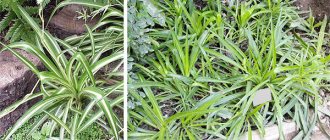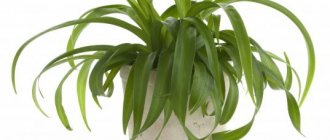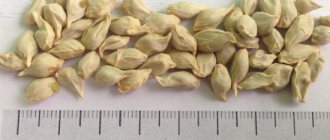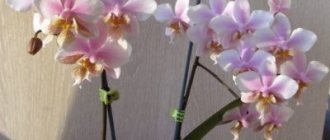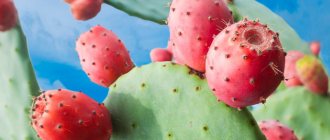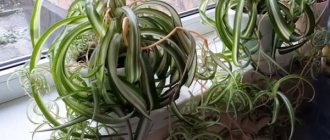Chlorophytum orange or orange, or winged chlorophytum, or fiery flash, and even fiery glory and tangerine - all these are names of one plant. And its full name is Chlorophytum amaniense, this is what botanists call it, and it is under this name that it joined our indoor flowers at the end of 2005.
For propagation as an indoor flower, we sell two varieties of orange chlorophytum:
- Chlorophytum amaniense "Fire flash"
- Chlorophytum amaniense "Green Orange"
Differences between “Fire flash” and “Green Orange” varieties
They are practically the same. Except that the coral vein in the middle of the leaf is less pronounced on Fire Flash. It’s not that it’s faded, it’s the same orange at the base of the leaf, and higher up, the orange color of the vein brightens and turns green.
Chlorophytum, with truly orange, bright, eye-catching petioles of dense green leaves, is another love at first sight for indoor plant lovers. Bright orange-coral petioles against the background of contrasting green leaves make it unusually attractive and interesting.
Fire flash is translated from English as a fiery flash - and it is truly a luminous beauty!
Botanical features of "Fire flash" and "Green Orange"
Botanical name:
Chlorophytum amaniense (synonyms Chlorophytum orchidantheroides, C. Orchidastrum, C. filipendulum amaniense, Chlorophytum Orange Marmalade and others)
The plant is known by the names:
fire flash, chlorophytum orange, chlorophytum orange, winged chlorophytum, Sierra Leone lily, orchidaceous, orange spider plant and about ten more names.
Such a huge number of names does not spoil the plant itself and cannot prevent us from admiring it. We are free to call him as we want, or as we are used to, as well as by the name under which he was first introduced to us.
Plant type:
A perennial deciduous plant native to the tropical forests of East Africa in the Usambara Mountains of Tanzania.
Chlorophytum has more than 200 species. Chlorophytum amaniense is one of the species, and Chlorophytum amaniense "Fire flash" and "Green Orange" are recognized varieties of this species. It is this fact that misleads many gardeners and causes controversy and confusion.
Description
Chlorophytum grows in the form of perennial rosettes or bunches, similar to “fountains” of long and narrow leaves, simply bright green, decorated with stripes, curly edges or bright petioles.
There are about 220 species of Chlorophytum in nature, and about 1000 varieties of the plant have been bred. The most popular species is Chlorophytum crested or in Latin Chlorophytum comosum.
The homeland of the plant, from where it was brought to our country, is the jungle of South America and Africa. Chlorophytum, a member of the Liliaceae family, is also called the "flying Dutchman", "champagne splash", "green lily" or "jolly family".
The following photo shows Chlorophytum at home:
Why is chlorophytum orange so similar to palisota?
I know of cases where flowers bought in a store died. Dissatisfied customers returned to the store with complaints. Where to look for the cause of death?
It was precisely because of the dissimilarity of “Fire flash” and “Green Orange” from the other representatives of this species that settled on our windowsills that flower growers began to have doubts. Is this flower named correctly? Are they taking care of it properly?
But the care complied with the rules for growing chlorophytums. Then maybe the object of care is not the one for which it is taken? Suspicions fell on Palisota. Look how similar they are. (Photo below) This is Palisota westlandia Commelinaceae, and it is a completely different flower from the same family as our common Tradescantia. This is the Commelinaceae family, and our hero is from the Liliaceae family. Well, of course, their care should be different.
Intrigue arose. But aren’t the stores making mistakes, and aren’t the suppliers making mistakes?
The Internet happily picked up the topic. Of course! Inflating a fly to the size of an elephant is as easy as shelling pears. But, as Vladimir Etush’s character said in “Prisoner of the Caucasus”: “Eh, there’s no need for haste, no need for haste.” Orange chlorophytum is also similar to aspidistra and many other representatives of the tropics.
In Australia there is a huge garden center Bamboo Land, which has its own online store. Great guys grow and sell plants all over the world. So they sell this plant, which causes so much controversy, under a very clever name: Chlorophytum X “Fire Flash”.
Because, they say, in fact, this is a hybridized plant and it would be more correct to spell its name with the letter X. And the actual species that were crossed to produce this beauty are unknown. So orange marmalade, aka fire flash, could look like anything, and only the breeders of the past know where they got such beauty from.
The same is true in the botanical definition of this beauty - it is a variety. That is, a plant obtained as a result of selection.
So, as Sharikov from “Heart of a Dog” said: “It definitely couldn’t have happened without a diver.”
Chlorophytum orange
The evergreen perennial grows to a height of 45-60 cm. If grown in containers it will not be so tall - 25-30 cm.
The leaves are green, glossy, oval-lanceolate, pointed, with wavy edges. Leaves up to 25-30 cm long and 5-10 cm wide grow in the shape of a rosette.
Fire Flash justifies its name by creating the impression of a luminous center of the outlet. The orange color of the petioles against the background of greenery looks like a fairytale backlight.
It blooms with small white flowers collected in paniculate inflorescences, resembling a panicle of corn. The flower rises on a very short peduncle from the middle of the rosette and blooms for a week. Then small boxes with seeds are formed from the flowers. The seeds are black. The flowers have a pleasant but slight aroma.
Click to enlarge
Almost, like their distant relatives 'Fire flash' and 'Green Orange', have tiny, swollen nodules in their root systems to store water. But they do not have the tendency to produce aerial roots, like their “relative”.
Click to enlarge
Chlorophytum orange - care
“Fire flash” and “Green Orange” prefer to be in the shade, they are very unpretentious - they sit quietly in the shade and always look good. They love to grow in the fresh air. In places where the air temperature fluctuates throughout the year from 15 to 27 degrees Celsius, they feel great somewhere under the trees. Can withstand short-term temperature drops of up to 10 degrees Celsius.
So in the summer they will be happy to move to the balcony, terrace or courtyard.
Light
Only diffused light, shadow, partial shade. Does not tolerate direct sunlight, which can cause chlorosis or leaf burns. It is very good to use in offices or in the decoration of rooms where there is little light.
Surprisingly, the abundance of light inhibits the growth of this member of the family. For planting outdoors, it grows best in the shade of trees. If the leaves are exposed to direct sun, brown spots appear, like freckles, or large damage like this.
Click to enlarge
And if there is just too much light, then the leaves can discolor to an unhealthy yellow color - chlorosis.
Watering
The soil should be moist, but, like most plants, not waterlogged. It is better to use non-fluoridated water. Fluoride also causes spots to appear on the leaves. It will last a week or two without watering. It will be saved by nodules on the roots, but not to the same extent as other chlorophytums, whose roots have pronounced moisture collectors.
In nature, chlorophytum prefers floodplains, so it will be happy with humidity even in indoor conditions. Although, if on the ground excess moisture goes into the soil itself, then the gardener will have to control the humidity in the pot. The danger of root rot is the same as with other potted plants.
The soil
Any humus or organically enriched. Well drained. Slightly acidic. It’s useful to know that universal soil is slightly acidic, so you don’t need to invent anything with the soil.
Benefits of the flower
Chlorophytum orange is a very useful plant. Its wide leaves absorb carbon dioxide from the air in large quantities, making the atmosphere in the room where the flower pot stands much cleaner. In addition, the plant secretes phytoncides that destroy pathogens. Moreover, an adult specimen is capable of killing up to 85% of bacteria located next to peas. Therefore, growing chlorophytum helps improve the indoor microclimate. And if you pour ground charcoal into a pot with a flower, the cleansing qualities of the flower will double.
Good to know:
The leaves are extremely sensitive to various chemicals, so when fertilizing, do not use foliar fertilizer, only at the root.
To preserve the strength and beauty of the leaves, remove the seed shoots unless you intend to produce seeds. Keep the plant well-groomed and dust off the leaves.
Maintain moisture during hot, dry times by placing the pot in a tray of water just above the base of the pot.
The leaves are brittle, that is, in a completely healthy state they can break in the middle and droop, like a hare’s ear.
Possible problems in cultivation and diseases
Yellowing of the leaf blade is a common problem
If you care for a flower incorrectly, certain problems and diseases will appear. It is necessary to start treatment on time, otherwise the plant will no longer be able to be saved.
Drops buds and leaves
If the foliage of a bush begins to dry out and fall off, the buds may soon suffer the same fate. This occurs due to rising temperatures and lack of watering. Therefore, you need to put the flower in the shade and increase the amount of watering.
The leaves are turning pale
The leaves begin to fade and lose their rich green color due to disturbances in the photosynthesis process. This problem usually occurs in winter due to lack of lighting. Therefore, for additional light, lamps are placed next to the pot.
The tips of the leaves are drying out
The tips of the leaf blades begin to dry out due to too dry air. The problem is solved by spraying the above-ground part with a spray bottle and a container of water, which is left next to the pot on the windowsill in the house.
The lower leaves fall off
Waterlogging of the soil and the appearance of pests are the reasons for the loss of the lower leaf plates. If treatment is not provided in time, the plant may completely lose its foliage and die.
Important! After each watering, it is necessary to loosen the soil.
Pests
Sometimes the flower suffers from attack by scale insects and aphids. They eat soft and succulent parts of plants. Insecticides are used against pests - special preparations that destroy parasites and insects.
In addition to the above, very often another problem arises when the leaves and shoots of the bush begin to turn black. This problem is one of the most destructive and dangerous. Its neglect promotes the formation of fungi and mold, which will gradually infect the entire plant from the roots to the crown. Therefore, you should not overdo it with watering and do not use cold and hard water for this.
Reproduction
Propagation by seeds
Excellent propagation by seeds. It reproduces on its own. He simply drops the seeds into his pot and they germinate. The seeds will hatch approximately a month after sowing. Sowing does not require any tricks.
The seeds are quite large. If you want to control the process, then bury the seeds a little in the same pot, next to the mother plant, and when seedlings appear, replant.
Like here, in the photo below. These seedlings are from the mother plant; they sprouted on their own, simply falling from their seed pods. Photo from the site: https://plantsarethestrangestpeople.blogspot.com/2008/01/brain-chlorophytum-x-fire-flash.html
Click to enlarge
If you purchased seeds for the first time, scatter them on well-moistened soil, and sprinkle about a centimeter thick with soil on top. That's all. Water as usual along with other plants, without allowing them to dry out.
It must be said that the orange color will not appear immediately in seedlings grown from seeds. Approximately 6 months must pass from sowing, and the leaves must reach a certain size before the main characteristic of the flower appears. It is interesting that many flower growers look forward to the appearance of orange color in seedlings, but decide that this property is not transmitted by sowing seeds and, in despair, decide to throw away the seedlings. And then a miracle happens.
Transfer
With proper care, orange or winged chlorophytum grows quickly and becomes cramped in an old pot. Therefore, replant young flowers into a new container every year. For adult specimens, carry out this event once every 3–4 years. Start the procedure at the end of February - beginning of March, before the active growth of the crop. Choose a clay pot for the plant, with a volume 10% larger than the previous one.
How to replant a crop:
- Place a layer of drainage at the bottom of the container. For these purposes, use small pebbles, broken bricks or expanded clay.
- Cover the drainage with a layer of substrate.
- Carefully remove the flower from the old pot and place it in a new container along with a lump of earth. To make the plant easier to remove, moisten the soil well the day before replanting.
- Fill the voids with substrate, compact it slightly and water well.
Repotting causes stress on the plant. To facilitate its adaptation, keep the culture for 3-4 days in a shaded place and only then return it to bright light.
